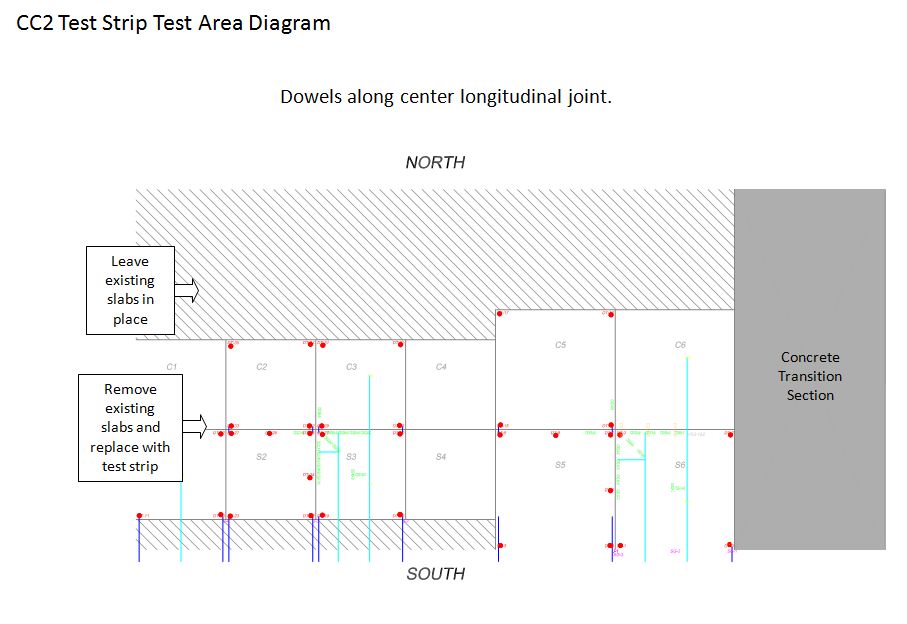Pavement Construction/Cross Section
This CC2 test strip replaced part of the existing CC1 Portland Cement Concrete
(PCC) test item over the low-strength subgrade. The CC1 test item had consisted
of three lanes of 20 ft. by 20 ft. concrete slabs. The slabs in the south and
center lanes were removed and replaced with the new slabs. The underlying Econocrete
(P-306) subbase was retained during their construction.
The plan called for careful removal of the existing cracked concrete
slabs and placement of new 28 cm (11-inch) thick PCC slabs on the existing
econocrete subbase. Both the 6 x 6 meters (20 x 20 feet), the size of the
original slabs, and the 4.5 x 4.5 meters (15 x 15 feet) test slabs were
constructed to evaluate the effect of different slab sizes in controlling
curling. The test strip south lane (slabs S) was placed on November 27, 2001,
using the new optimized mix design (3-part mix). The 2-part mix, same as in the
original construction, was placed in the test strip north lane (slabs C) on
November 30, 2001. The layout of the test strip is shown in the Figure below.






A three-aggregate concrete mix was placed in the south lane. A
two-aggregate mix, similar to the one used in the original CC1, was placed in
the center lane. A formed longitudinal joint, reinforced with steel dowels,
provided the boundary between the north and south lanes. Saw-cut grooves
provided the transverse boundaries between slabs. As temperatures dropped
during the winter months, the grooves induced cracking, forming joints at the
slab boundaries. The slabs were covered with burlap and wet-cured for 28 days.
The concrete was placed in November 27-30, 2001.
Test Strip Curing
Poor curing procedures were suspected for the early corner cracks in the
original construction cycle due to the NAPTF being an enclosed facility.
Special curing procedures were included in the test plan to prevent any
possible curling due to lack of proper curing. The slabs in both lanes were
covered with burlap for a 28-day wet cure period to fully hydrate the cement in
a moist environment. Additionally, insulating blankets were placed on two 4.5 x
4.5 meters (15 x 15 feet) slabs (C1 and S1). The blankets were left in place to
achieve and maintain no more than a 5 - 8 ºC (10 – 15 ºF) temperature
differential between top and bottom of the slabs for the first three days. The
blankets were placed to establish a favorable thermal gradient to induce the
slabs to assume a “curl down” shape, thereby promoting full support at the slab
corners. A layer of plastic was also placed over slabs C1 and S1 to reduce moisture loss. At the
completion of the 28-day wet cure, a liquid sealing membrane was applied to
slabs C1 and S1.
More than 200 sensors were embedded in the test slabs for data
collection. The sensors were of two types, static and dynamic. Static sensors
were used to monitor temperature and moisture. Moisture sensors existed
in the subgrade from CC1 and were re-used. Experimental vibrating wire strain
gauges and resistance crack indicators were also part of the static system.
Dynamic sensors measured concrete strains and pavement deflections. Test
vehicle operations triggered data retrieval from the dynamic sensors at an
increased sampling rate. Sensor data collected during both traffic and
non-traffic time periods were processed and stored in a computer database
maintained on-site. The database is searchable online using the link below.
Search CC-2 Test Strip Database